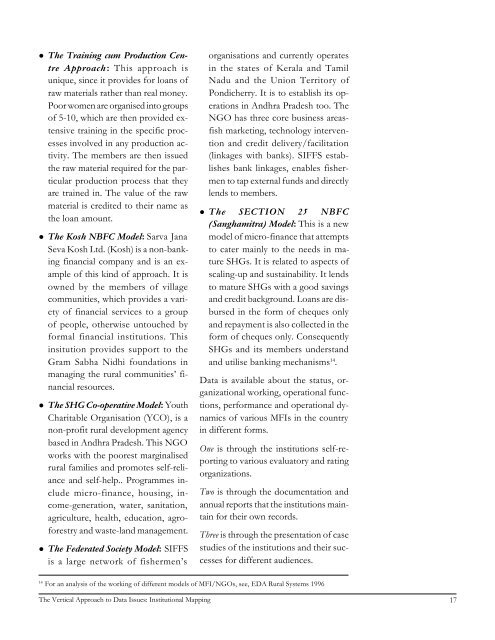Women's Access to Credit and Rural Micro-finance in India
Women's Access to Credit and Rural Micro-finance in India
Women's Access to Credit and Rural Micro-finance in India
You also want an ePaper? Increase the reach of your titles
YUMPU automatically turns print PDFs into web optimized ePapers that Google loves.
• The Tra<strong>in</strong><strong>in</strong>g cum Production Centre<br />
Approach: This approach is<br />
unique, s<strong>in</strong>ce it provides for loans of<br />
raw materials rather than real money.<br />
Poor women are organised <strong>in</strong><strong>to</strong> groups<br />
of 5-10, which are then provided extensive<br />
tra<strong>in</strong><strong>in</strong>g <strong>in</strong> the specific processes<br />
<strong>in</strong>volved <strong>in</strong> any production activity.<br />
The members are then issued<br />
the raw material required for the particular<br />
production process that they<br />
are tra<strong>in</strong>ed <strong>in</strong>. The value of the raw<br />
material is credited <strong>to</strong> their name as<br />
the loan amount.<br />
• The Kosh NBFC Model: Sarva Jana<br />
Seva Kosh Ltd. (Kosh) is a non-bank<strong>in</strong>g<br />
f<strong>in</strong>ancial company <strong>and</strong> is an example<br />
of this k<strong>in</strong>d of approach. It is<br />
owned by the members of village<br />
communities, which provides a variety<br />
of f<strong>in</strong>ancial services <strong>to</strong> a group<br />
of people, otherwise un<strong>to</strong>uched by<br />
formal f<strong>in</strong>ancial <strong>in</strong>stitutions. This<br />
<strong>in</strong>sitution provides support <strong>to</strong> the<br />
Gram Sabha Nidhi foundations <strong>in</strong><br />
manag<strong>in</strong>g the rural communities’ f<strong>in</strong>ancial<br />
resources.<br />
• The SHG Co-operative Model: Youth<br />
Charitable Organisation (YCO), is a<br />
non-profit rural development agency<br />
based <strong>in</strong> Andhra Pradesh. This NGO<br />
works with the poorest marg<strong>in</strong>alised<br />
rural families <strong>and</strong> promotes self-reliance<br />
<strong>and</strong> self-help.. Programmes <strong>in</strong>clude<br />
micro-<strong>f<strong>in</strong>ance</strong>, hous<strong>in</strong>g, <strong>in</strong>come-generation,<br />
water, sanitation,<br />
agriculture, health, education, agroforestry<br />
<strong>and</strong> waste-l<strong>and</strong> management.<br />
• The Federated Society Model: SIFFS<br />
is a large network of fishermen’s<br />
organisations <strong>and</strong> currently operates<br />
<strong>in</strong> the states of Kerala <strong>and</strong> Tamil<br />
Nadu <strong>and</strong> the Union Terri<strong>to</strong>ry of<br />
Pondicherry. It is <strong>to</strong> establish its operations<br />
<strong>in</strong> Andhra Pradesh <strong>to</strong>o. The<br />
NGO has three core bus<strong>in</strong>ess areasfish<br />
market<strong>in</strong>g, technology <strong>in</strong>tervention<br />
<strong>and</strong> credit delivery/facilitation<br />
(l<strong>in</strong>kages with banks). SIFFS establishes<br />
bank l<strong>in</strong>kages, enables fishermen<br />
<strong>to</strong> tap external funds <strong>and</strong> directly<br />
lends <strong>to</strong> members.<br />
• The SECTION 25 NBFC<br />
(Sanghamitra) Model: This is a new<br />
model of micro-<strong>f<strong>in</strong>ance</strong> that attempts<br />
<strong>to</strong> cater ma<strong>in</strong>ly <strong>to</strong> the needs <strong>in</strong> mature<br />
SHGs. It is related <strong>to</strong> aspects of<br />
scal<strong>in</strong>g-up <strong>and</strong> susta<strong>in</strong>ability. It lends<br />
<strong>to</strong> mature SHGs with a good sav<strong>in</strong>gs<br />
<strong>and</strong> credit background. Loans are disbursed<br />
<strong>in</strong> the form of cheques only<br />
<strong>and</strong> repayment is also collected <strong>in</strong> the<br />
form of cheques only. Consequently<br />
SHGs <strong>and</strong> its members underst<strong>and</strong><br />
<strong>and</strong> utilise bank<strong>in</strong>g mechanisms 14 .<br />
Data is available about the status, organizational<br />
work<strong>in</strong>g, operational functions,<br />
performance <strong>and</strong> operational dynamics<br />
of various MFIs <strong>in</strong> the country<br />
<strong>in</strong> different forms.<br />
One is through the <strong>in</strong>stitutions self-report<strong>in</strong>g<br />
<strong>to</strong> various evalua<strong>to</strong>ry <strong>and</strong> rat<strong>in</strong>g<br />
organizations.<br />
Two is through the documentation <strong>and</strong><br />
annual reports that the <strong>in</strong>stitutions ma<strong>in</strong>ta<strong>in</strong><br />
for their own records.<br />
Three is through the presentation of case<br />
studies of the <strong>in</strong>stitutions <strong>and</strong> their successes<br />
for different audiences.<br />
14<br />
For an analysis of the work<strong>in</strong>g of different models of MFI/NGOs, see, EDA <strong>Rural</strong> Systems 1996<br />
The Vertical Approach <strong>to</strong> Data Issues: Institutional Mapp<strong>in</strong>g<br />
17
















